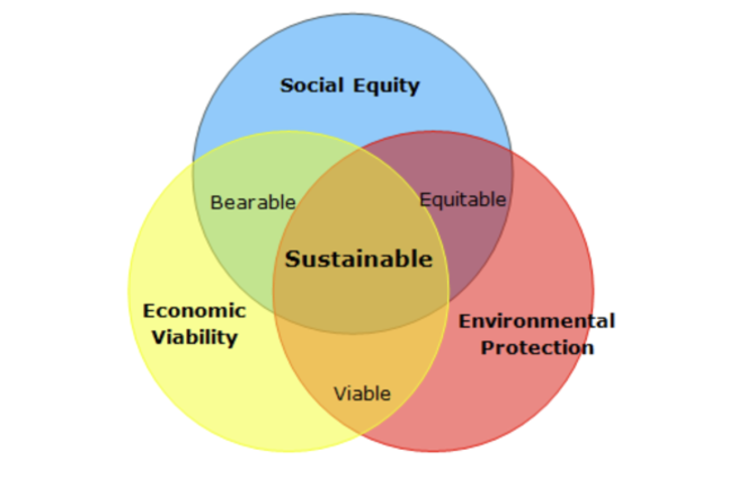SDIA definition

When the SDIA refers to sustainability it refers to the three pillars of sustainability as defined by the Environmental Protection Agency:
Sustainability is often represented diagrammatically. The figure at the top of this page suggests that there are three pillars of sustainability – economic viability, environmental protection and social equity. (Environmental Protection Agency, https://www.futurelearn.com/info/courses/sustainability-society-and-you/0/steps/4618)
In this context, the SDIA stimulates sustainable digital infrastructure that is both economically viable, has a positive effect on the environment, and promotes social equity.
The EPA further explains these pillars of sustainability through three different perspectives:
The Ecologist doesn’t see the human race as a separate entity from the planet and its resources, but part of it. Their motivations for preserving the planet are that nature and humanity have an inherent value and should be protected because of that. The Environmentalist sees nature or the planet as separate from the human race. It is there for humans, and as such humans should have stewardship over the world. They see the planet as something to be preserved so that humans can survive and evolve. The Economist understands the measures of unsustainability arising from a consumer led culture treating finite resources as an income, but has faith that market forces and a “business as usual” approach will result in a natural crisis aversion occurring; that the system will sort itself out through technological advances if left to its own devices. (Environmental Protection Agency, https://www.futurelearn.com/info/courses/sustainability-society-and-you/0/steps/4618)
The SDIA thus strives to integrate all three of these perspectives in its goals for digital infrastructure.
Other definitions
Here we collect other definitions of the terms with a reference to the source.
The UN defines sustainability as:
In 1987, the United Nations Brundtland Commission defined sustainability as “meeting the needs of the present without compromising the ability of future generations to meet their own needs.” Today, there are almost 140 developing countries in the world seeking ways of meeting their development needs, but with the increasing threat of climate change, concrete efforts must be made to ensure development today does not negatively affect future generations. (https://www.un.org/en/academic-impact/sustainability)
The European Union defines sustainability as:
Sustainable development is development that meets the needs of current generations without compromising the ability of future generations to meet theirs. (https://ec.europa.eu/info/publications/reflection-paper-towards-sustainable-europe-2030_en#:~:text=First published on,deeply rooted in European policies.)
John Mirelli from the Rochester Institute of Technology explains the interdisciplinary nature of sustainability.
Whether one considers sustainability to exist as a three-legged table consisting of the environment, the economy, and society, or as a dualistic relationship between human beings and the ecosystem they inhabit, there should at least be agreement that ensuring the provision of clean air, clean water, and clean and productive land is foundational to a responsible socioeconomic system. [...] If it can be agreed that a sustainable environment is a necessary prerequisite to a sustainable socio-economic system, then it also should make sense that the actions we take to remove threats to and foster environmental sustainability should contribute to such a system. (Mirelli, “Environmental Sustainability: A Definition for Environmental Professionals,” p. 3 - 4)
In terms of environmental sustainability, this term is most easily explained through Robert Goodland’s explanation of the term.
Natural capital - the natural environment - is defined as the stock of environmentally provided assets (such as soil, atmosphere, forests, water, wetlands), which provide a flow of useful goods or services; these can be renewable or nonrenewable, and marketed or nonmarketed. Sustainability means maintaining environmental assets, or at least not depleting them. (Goodland, “THE CONCEPT OF ENVIRONMENTAL SUSTAINABILITY,” p. 14)
Related SDIA publications
If there is related SDIA publications, put them here (please only use SDIA website links or Notion links and do not upload or post documents here)
Related non-SDIA publications
For more contextual explanation of sustainability, read Robert Goodland’s article “THE CONCEPT OF ENVIRONMENTAL SUSTAINABILITY” here.
Changelog
If you change an existing definition, please add the date and reasoning below.
Date | Change explanation | Change by |
23/05/22 | Added the UN definition of sustainability. | Inky |
ㅤ | ㅤ | ㅤ |
